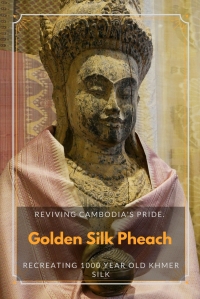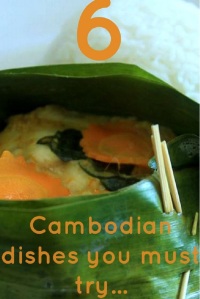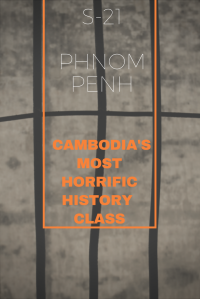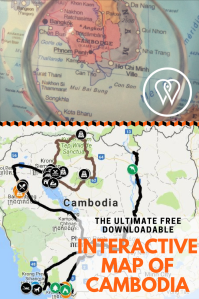The traffic is hectic. I am manoeuvring our 125cc scooter to avoid pedestrians randomly crossing the street, scooters coming from all sides, including in front of me and against traffic, and tuk-tuk drivers slaloming between trucks, buses and cars. Driving in these conditions requires an intense focus. Still, my mind is lingering at S-21 we have just left. The depiction of the atrocities committed in this prison under the Khmer Rouge regime has left such a deep impression that we can hardly utter a word to each other. As we are heading South, the traffic gets slightly lighter, and potholes get me out of my thoughts. These victims who survived the tortures of S-21 may have felt the same potholes while being driven to the village of Chhoeung Ek, about half an hour away from Phnom Penh, today known as the killing fields.

After detention in S-21 and frequent tortures to confess to crimes against the revolution that most of them didn’t commit, prisoners were told they were being transferred to a new house. Loaded in the back of trucks, 50 to 70 men, women, elderlies and children were moved at a time, several days a week. The trucks followed the same bumpy road we drove today. The ride must have been a lot quieter through the ghost town of Phnom Penh, emptied of its inhabitants as soon as Pol Pot took power on the 17th of April 1975. It took about 30 minutes for the slow military trucks to arrive to Chhoeung Ek.
Unloaded, at night, victims arrived blindfolded and cuffed behind their backs, with no idea about what was about to happen to them.
Noisy diesel generators provided power for the lights that were turned on when the executions started. Speakers were blasting the happy-sounding communist songs about Kampuchea Democratic to cover the screams. Kneeling in front of their pits, victims were killed, one by one. As bullets were expensive, anything cheap was used by the Khmer Rouge soldiers: machetes, bamboo sticks, axes, farming tools… Then, the bodies were thrown in the pits, and chemicals were spread on to them to finish killing the ones who may not be dead yet, and to cover the stench of decomposition.
The Khmer Rouge rule stated that it is better to kill an innocent by mistake than to spare an enemy by mistake. And to make sure that no one would seek revenge, when one family member was executed, all the family was exterminated. Including young children and babies. There was a tree for this. No one who has seen that tree will ever forget. How can one clench onto the feet of a baby and smash its head onto a tree? But if one doesn’t kill, one is a traitor of the revolution and next in line. To rule Kampuchea Democratic, Pol Pot trusted a small group of educated leaders and relied on uneducated and poor country teenagers not spoilt by the urban bourgeois society and malleable. Brainwashed by the regime they committed unspeakable atrocities. They are also considered victims today.
By 1978, the Khmer Rouge soldiers of the killing fields couldn’t keep up with the up to 300 prisoners brought in weekly. Some of them had to wait for another night before being slaughtered, probably understanding what was about to happen.
More than 40 years later, bones, teeth and clothing still appear out of the shallow mass graves scattered throughout the killing fields. They are methodically collected so that respects can be paid to the victims who have been deprived of a proper burial for years. An estimated 1.3 million Cambodians were slaughtered by their own in one of the 300 killing fields throughout the country during the Cambodian genocide.
Claire
Notes:
- The estimated number of casualties of the Khmer Rouge regime is 2 million people, or about a fourth of the country at the time of events, killed by its own.
- After the fall of the Khmer Rouge, Pol Pot fled to Thailand and remained the head of the Khmer Rouge who were still representing Cambodia and seating at the UN in New York City and receiving international financial aid, while the new Cambodian government was ignored.
- The Extraordinary Chambers in the Courts of Cambodia (ECCC) is special court that was put in place to try the senior leaders of the Khmer Rouge. At the time of publishing, three of the top leaders recently received a life imprisonment sentence.
- For a broader and in-depth understanding of the Khmer Rouge regime, refer to S21 The Khmer Rouge killing machine documentary (contains shocking images).
- As travelers, we strongly believe that we have a duty to try and understand the history of the countries we visit. Understanding history, and its darkest moments, is a way of commemorating victims while keeping a critical mind on our present. While writing this article, we cannot help but thinking about the alarming events that have been taking place in Syria and bear horrific similarities.
Travel tips:
- We recommend visiting S-21 before heading to the killing fields for a better understanding of the Khmer Rouge regime and of what happened during the Cambodian genocide.
- Check out this interactive map for the specific details to help you plan your trip and more articles and photos (zoom out) about the area!
Don’t know where to start? Get inspired:














14 Comments Add yours